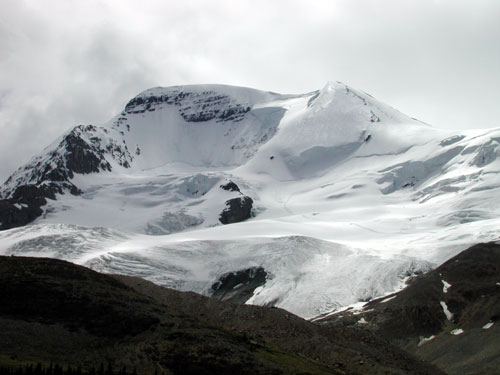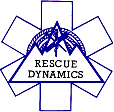| Mt. Athabasca North Glacier Route - July 9, 2003 |
 |
The North Glacier Route on Mt. Athabasca
This once popular route actually has many obvious and hidden dangers that will be described below. This is one of the choices for the summit day on day three of the Basic Snow and Ice Course (day five of Intro to Mountaineering). The summit is 11.452 feet / 3491 meters above sea level which means altitude sickness, although rare, is possible and has happened here. Quite often fit individuals will suffer from minor affects of altitude during our climbs. Headaches and feeling unduly tired are common complaints. Keeping hydrated and fed are two ways to combat this, along with proper pacing and well spaced breaks.
Crevasse hazard is very real on this route and varies depending upon the time of year, the time of day and the quality of the snowpack. Good routefinding and proper ropework are essential to safety. Sometimes a slip or fall is more of a danger than crevasses so the way in which the rope is used will vary as the day progresses. In addition, depending upon the conditions, the way in which the rope will be used can vary from one day to the next even when travelling on exactly the same route. Judgment and situational awareness are key to proper ropework.
The north glacier route traverses under seracs and icefall. This means that large blocks of ice can suddenly break off and without warning fall down the mountain. Ice fall has gone right across the normal route in the past. The equivalent to a large size 4 avalanche ran across the normal route in the 1990s. Fortunately this occurred during the night when there were no parties on the route.
Avalanches can also happen here especially on and under the part of the mountain called the "Silverhorn". In the mid - 1990s a non-guided party was hit by a sizeable (Size 2) avalanche from above. Avalanches here are more likely just after a snow storm or in the afternoon as the snow warms up and weakens. Avalanches are also more likely on a day following a warm night during which the snow did not freeze well at night. Best to wait for a cold clear night to freeze things in place, then get up very early and start your climb in the dark so that the descent is made early in the day before the hazard level rises. You also have to be willing to turn back if conditions are too warm or the snow is still moist early in the morning.
During our guided ascents we now only take groups on this route when we feel the conditions are just right, otherwise we opt for the less objectively hazardous AA Col Route. Sometimes we will ascend one route and descend another if conditions warrant a change of plan.
The photos in this essay were taken on Day 5 of the Introduction to Mountaineering Course (Day Three of the Basic Snow and Ice Course). The group is obviously young and fit and we made reasonable time as conditions were fairly good, although not perfect as trailbreaking was more difficult than normal.
|
![[N Face Photo]](Approach070903.jpg) |
|
Ascending the Moraine - 05:00 AM
The group started up at around 04:00 AM ! |
![[Pitch 2 Photo]](Ropeup070903.jpg) |
| Roping Up Just Before Sunrise - 05:30 AM |
![[Leading Pitch 5 Photo]](Alpenglow070903.jpg) |
| Alpenglow on the Upper Mountain - 05:35 AM |
![[Pitch 5 Photo]](LowerGlac070903.jpg) |
Ascending the Lower Glacier - 06:50 AM
After a clear, cold night, clouds begin rolling in, keeping temperatures cool. The type of clouds signal winds up above. Travel is roped up due to crevasse risk.
|
![[Pitch 5 Photo]](DangerA070903.jpg) |
Danger, Don't Stop ! - 07:00 AM
Risk of avalanches and icefall from above (although low in this instance due to good conditions) necessitate a constant pace without stopping. A non-guideded group was hit by an avalanche here in the mid -1990s when a snowstorm and winds had deposited a slab of snow on the slopes above. You can notice a small avalanche from a few days ago on the left center of the photo.
|
![[Pitch 6 Photo]](Traverse070903.jpg) |
The Traverse below the Silverhorn - 07:40 AM
Steeper terrain and the risk of a fall are the hazards of the traverse over to the broad 'saddle' where the group intends to take a break. The distance between climbers was shortened temporarily and will be lengthened again very soon when the crevasse risk outweighs the risk of a slip.
|
![[Pitch 7 Photo]](Serac070903.jpg) |
Serac Danger ! - 08:00AM
The group moves quickly to avoid any extra time underneath the overhanging ice walls. A well deserved rest stop will come a bit later once past this hazard. The break for another snack will take place where the terrain is less steep with lower crevasse risk.
|
![[Crux Pitch Photo]](11000070903.jpg) |
Eleven Thousand Feet / 3353 Meters - 09:10 AM
After a fifteen minute break a thousand feet below for food water and to recharge the internal batteries, the group cracks the 11,000 foot elevation mark (3353m). Extra layers of clothes were added below to deal with the wind and cold temperatures at this altitude. The group is now dressed for a winter day in mid-July!
The thinner air begins to slow the pace even further. Many people find elevations above 10,000' / 3000m taxing unless their bodies are acclimatized. Some people find their hearts racing and must slow their pace or stop every few minutes to catch their breath. Other people hardly notice the elevation at all. Fitness does not necessarily imply immunity either. I have seen a trained marathon runner "hit the wall" at 10,000' while other less fit people on the rope seemed totally unaffected.
|
![[Lee on Pitch 7 Photo]](Silverhorn070903.jpg) |
The Silverhorn - Almost There - 09:24 AM
From the top of the Silverhorn where this photo was taken to the summit of Mt. Athabasca proper usually takes between fifteen and twenty minutes depending upon conditions.
|
![[Lee Past Crux Photo]](Summit070903.jpg) |
SUMMIT ! 11,452 feet / 3491 meters - 09:40 AM
The next step onto the very narrow summit is a tricky one. On the summit there is just enough time for some photos and a snack but not for too long as the lower slopes are already beginning to get warm. By 10 AM the group has to depart.
|
![[Photo of Cyril on Summit]](SilverhornB070903.jpg) |
Back on the Silverhorn with the Summit Behind - 10:22 AM
The group has only completed half the climb. Getting back down is just as important as getting to the top. Tired legs can easily misstep and softer snow makes bridges over crevasses more likely to collapse. Best to pay attention until the very end.
|
![[Photo of Lee on Summit]](DescentSil070903.jpg) |
Descending the Silverhorn - 10:25 AM
The snow at 11,000' is still hard enough to require crampons today and the group travels with a shortened rope distance between them as a slip and fall is a possible hazard. It is easier to check a slip with less rope between climbers. Lower down once the group gets onto the crevassed portion of the glacier again the rope between climbers will be lengthened for normal glacier travel.
|
![[Photo of Lee on Summit]](Change070903.jpg) |
Changing Gears - 11:15 AM
Having lost well over 2000 feet (600m) in the last hour the group is just getting into warmer snow which is balling up in their crampons. Time to remove crampons, adjust clothing and lengthen the rope again. The group had lengthened the rope and shortened it again for various situation changes in the last hour. Good rope management requires situational awareness.
Notice the avalanche debris from several days ago just right of the group. In poor conditions avalanches can easily run this far or farther. This will not be a long break, just a quick pit stop. Better to take a real break in a safer place.
|
![[Photo of top of N Face]](Unroped070903.jpg) |
Off the Glacier and Off the Rope - 12:10 Noon
The group can now begin to relax a little as the hazards of altitude, crevasses, icefall, seracs, slips and falls on snow and ice are behind them. Just another thousand feet or more of elevation to lose to get back to the vehicles. There are still plenty of opportunities to get injured on loose ground on the moraines, so they can't quite relax completely.
|
![[Photo of top of N Face]](Moraine070903.jpg) |
Just about down - 12:40 PM
With Mt. Athabasca now looking to be far in the background the group makes short work of the final walk down the moraine. In five more minutes they will be back at the vehicles taking their boots off and feeling the deep satisfaction of having safely been to the top of an awesome peak.
This group made the return trip in about eight and a half hours which is pretty normal. Between eight and ten hours is standard for this route in normal conditions. If conditions were better it is possible to be quite a bit faster with a young fit group such as this one. Conversely when conditions are worse it has taken more than twelve hours to climb Mt. Athabasca. A less fit group would not have dealt as well with the altitude and conditions and the trip could have taken longer.
It is essential on peaks of this type to get up very early, start early and try to finish early before deteriorating conditions make travel even slower and more dangerous. On some ascents we leave the vehicles as early as 03:00 in the morning. On days when things are not right, groups must be willing to turn back, change routes or sometimes change objectives entirely to climb a safer line or a safer mountain.
Stay Safe!
|
![[Made with Macintosh Icon]](../../images/macmadeg4.gif)
Further Information, Comments, Suggestions?
Cyril Shokoples
Rescue Dynamics
Edmonton, AB, Canada T6L 1K5
Copyright © 1997 Cyril Shokoples
All rights reserved. Terms & Conditions apply.
Last updated Monday, May 29, 2023
|

![[N Face Photo]](Approach070903.jpg)
![[Pitch 2 Photo]](Ropeup070903.jpg)
![[Leading Pitch 5 Photo]](Alpenglow070903.jpg)
![[Pitch 5 Photo]](LowerGlac070903.jpg)
![[Pitch 5 Photo]](DangerA070903.jpg)
![[Pitch 6 Photo]](Traverse070903.jpg)
![[Pitch 7 Photo]](Serac070903.jpg)
![[Crux Pitch Photo]](11000070903.jpg)
![[Lee on Pitch 7 Photo]](Silverhorn070903.jpg)
![[Lee Past Crux Photo]](Summit070903.jpg)
![[Photo of Cyril on Summit]](SilverhornB070903.jpg)
![[Photo of Lee on Summit]](DescentSil070903.jpg)
![[Photo of Lee on Summit]](Change070903.jpg)
![[Photo of top of N Face]](Unroped070903.jpg)
![[Photo of top of N Face]](Moraine070903.jpg)
